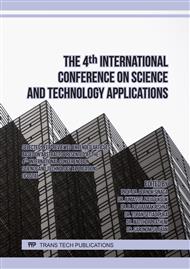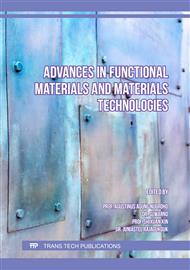[1]
U. Muksin, Irwandi, I. Rusydy, Muzli, K. Erbas, Marwan, Asrillah, Muzakir, and N. Ismail, Investigation of Aceh Segment and Seulimeum Fault by Using Seismological Data; A Preliminary Result, in Journal of Physics: Conference Series, Vol. 1011 (2018), p.012031.
DOI: 10.1088/1742-6596/1011/1/012031
Google Scholar
[2]
M. Yanis, A. Faisal, A. Yenny, Z. Muzakir, M. Abubakar, and I. Nazli, Continuity of Great Sumatran Fault in the Marine Area Revealed by 3D Inversion of Gravity Data, J. Teknol. 83, 145 (2020).
DOI: 10.11113/jurnalteknologi.v83.14824
Google Scholar
[3]
P. Franchin and F. Cavalieri, Probabilistic Assessment of Civil Infrastructure Resilience to Earthquakes, Comput. Civ. Infrastruct. Eng. 30, 583 (2015).
DOI: 10.1111/mice.12092
Google Scholar
[4]
P. Inyim, J. Pereyra, M. Bienvenu, and A. Mostafavi, Environmental Assessment of Pavement Infrastructure: A Systematic Review, J. Environ. Manage. 176, 128 (2016).
DOI: 10.1016/j.jenvman.2016.03.042
Google Scholar
[5]
D. Mason, P. Brabhaharan, and G. Saul, Performance of Road Networks in the 2016 Kaikōura Earthquake: Observations on Ground Damage and Outage Effects, in Proceedings of the 20th NZGS Geotechnical Symposium (2017), p.24–26.
Google Scholar
[6]
I. Rusydy, Ikhlas, B. Setiawan, M. Zainal, S. Idris, K. Basyar, and Y. A. Putra, Integration of Borehole and Vertical Electrical Sounding Data to Characterise the Sedimentation Process and Groundwater in Krueng Aceh Basin, Indonesia, Groundw. Sustain. Dev. 10, 100372 (2020).
DOI: 10.1016/j.gsd.2020.100372
Google Scholar
[7]
R. Gupta, An Assessment of Development Impact of Rural Roads, Acad. An Int. Multidiscip. Res. J. 5, 48 (2015).
Google Scholar
[8]
M. Yanis, M. Zainal, M. Marwan, and N. Ismail, Delineation of Buried Paleochannel Using EM Induction in Eastern Banda Aceh, Indonesia, in 81st EAGE Conference and Exhibition 2019 (2019).
DOI: 10.3997/2214-4609.201900705
Google Scholar
[9]
M. Zainal, B. Munir, and Marwan, The Electrical Resistivity Tomography Technique for Landslide Characterization in Blangkejeren Aceh, in Journal of Physics: Conference Series (2021).
DOI: 10.1088/1742-6596/1825/1/012022
Google Scholar
[10]
M. Rizal, N. Ismail, M. Yanis, Muzakir, and M. S. Surbakti, The 2D Resistivity Modelling on North Sumatran Fault Structure by Using Magnetotelluric Data, in IOP Conference Series: Earth and Environmental Science, Vol. 364 (2019).
DOI: 10.1088/1755-1315/364/1/012036
Google Scholar
[11]
M. Yanis, G. Islami, and N. Ismail, Geophysics and Geomorphic Observation for Near-Surface Structures Mapping of Seulimeum Fault on Lamtamot Area, Northern Sumatra, Bull. Geol. Soc. Malaysia 73, 139 (2022).
DOI: 10.7186/bgsm73202211
Google Scholar
[12]
A. Klotzsche, F. Jonard, M. C. Looms, J. van der Kruk, and J. A. Huisman, Measuring Soil Water Content with Ground Penetrating Radar: A Decade of Progress, Vadose Zo. J. 17, 180052 (2018).
DOI: 10.2136/vzj2018.03.0052
Google Scholar
[13]
X. Liu, M. Serhir, and M. Lambert, Detectability of Junctions of Underground Electrical Cables with a Ground Penetrating Radar: Electromagnetic Simulation and Experimental Measurements, Constr. Build. Mater. 158, 1099 (2018).
DOI: 10.1016/j.conbuildmat.2017.10.038
Google Scholar
[14]
F. J. Prego, M. Solla, I. Puente, and P. Arias, Efficient GPR Data Acquisition to Detect Underground Pipes, NDT E Int. 91, 22 (2017).
DOI: 10.1016/j.ndteint.2017.06.002
Google Scholar
[15]
Š. Bezina, I. Stančerić, J. Domitrović, and T. Rukavina, Spatial Representation of GPR Data—Accuracy of Asphalt Layers Thickness Mapping, Remote Sens. 13, 1 (2021).
DOI: 10.3390/rs13050864
Google Scholar
[16]
S. Zhao and I. L. Al-Qadi, Development of an Analytic Approach Utilizing the Extended Common Midpoint Method to Estimate Asphalt Pavement Thickness with 3-D Ground-Penetrating Radar, NDT E Int. 78, 29 (2016).
DOI: 10.1016/j.ndteint.2015.11.005
Google Scholar
[17]
A. P. Annan, Ground-Penetrating Radar, in Near-Surface Geophysics (Society of Exploration Geophysicists, 2005), p.357–438.
DOI: 10.1190/1.9781560801719.ch11
Google Scholar
[18]
A. M. Alani and F. Tosti, GPR Applications in Structural Detailing of a Major Tunnel Using Different Frequency Antenna Systems, Constr. Build. Mater. 158, 1111 (2018).
DOI: 10.1016/j.conbuildmat.2017.09.100
Google Scholar
[19]
K. Zajícová and T. Chuman, Application of Ground Penetrating Radar Methods in Soil Studies: A Review, Geoderma 343, 116 (2019).
DOI: 10.1016/j.geoderma.2019.02.024
Google Scholar
[20]
Zhong-lai Huang and Jianzhong Zhang, Determination of Parameters of Subsurface Layers Using GPR Spectral Inversion Method, IEEE Trans. Geosci. Remote Sens. 52, 7527 (2014).
DOI: 10.1109/tgrs.2014.2313603
Google Scholar
[21]
A. K. Khamzin, A. V. Varnavina, E. V. Torgashov, N. L. Anderson, and L. H. Sneed, Utilization of Air-Launched Ground Penetrating Radar (GPR) for Pavement Condition Assessment, Constr. Build. Mater. 141, 130 (2017).
DOI: 10.1016/j.conbuildmat.2017.02.105
Google Scholar
[22]
A. F. B. Hisham, M. H. Razali, A. N. Idris, R. Ghazali, and N. Ibrahim, Determination Asphalt Layer Using Ground Penetrating Radar (GPR), in IOP Conference Series: Earth and Environmental Science, Vol. 1051 (IOP Publishing, 2022), p.12005.
DOI: 10.1088/1755-1315/1051/1/012005
Google Scholar
[23]
M. R. Mahmoudzadeh, J.-B. Got, S. Lambot, and C. Grégoire, Road Inspection Using Full-Wave Inversion of Far-Field Ground-Penetrating Radar Data, in 2013 7th International Workshop on Advanced Ground Penetrating Radar (IEEE, 2013), p.1–6.
DOI: 10.1109/iwagpr.2013.6601522
Google Scholar



